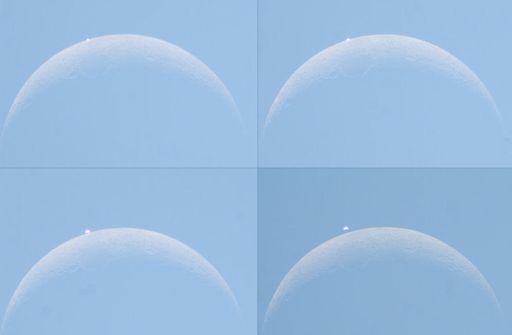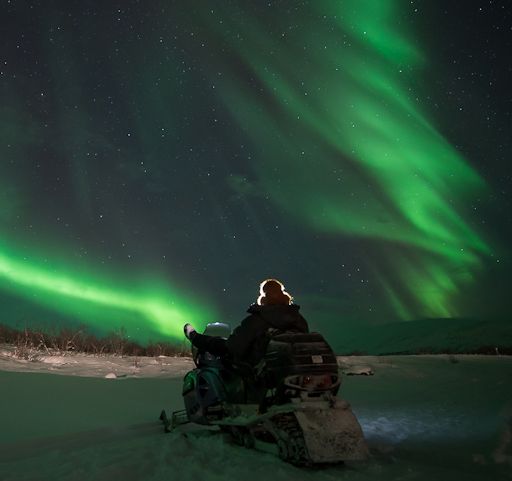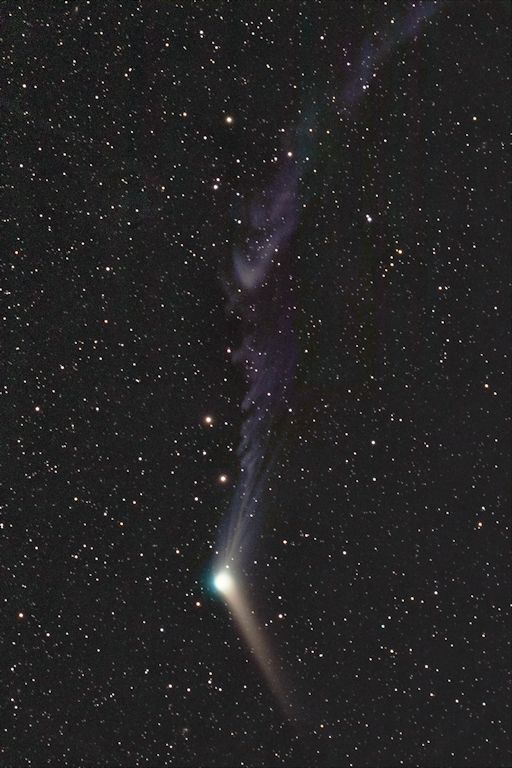Marianne's Heaven On Earth Aurora Chaser Tours Chasethelighttours.co.uk invites you to join them in their quest to find and photograph the Aurora Borealis. Experience the winter wonderland in the Tromsø Area. | | | DAYTIME OCCULTATION OF VENUS: Set your alarm for dawn. On Monday, Dec. 7th, Venus and the crescent moon will have a beautiful close encounter in the eastern sky just before sunrise. The sight of Venus and the Moon in tight formation, framed by twilight blue, is a great way to start the day. [photo gallery] For observers in North America, the show is not over at sunrise. The Moon is going to pass right in front of Venus in broad daylight. The occultation will look something like this: 
Spaceweather.com reader Kerneels Mulder took these pictures on Sept. 11, 2010, when a similar occultation took place over South Africa. The Dec. 7, 2015, occultation may be seen from almost all of North America: visibility map. On the west coast, Venus disappears behind the edge of the Moon around 8:00 a.m. Pacific Time (e.g., 7:53 a.m. in Seattle, 8:03 a.m. in Los Angeles). On the east coast, the event commences around 12:30 p.m. Eastern Time (e.g., 12:42 p.m. in Boston, 12:31 p.m. in Atlanta). Start watching at least a half hour early before Venus disappears. Venus is easy to see in broad daylight--if you know where to look--and on Dec. 7th the Moon will lead you right to it. More information about this event is available from Sky and Telescope Realtime Space Weather Photo Gallery SOLAR WIND SPARKS AURORAS: Earth is entering a stream of solar wind flowing from a broad coronal hole on the sun. First contact with the stream on Dec. 5th sparked bright auroras around the Arctic Circle. Chad Blakley sends this picture from Abisko National Park in Sweden: 
"Last night I spent most of the evening helping our guides prepare for their Nightly Aurora Photo Tours in Abisko National Park," says Blakley. "After I finished helping the guides I could not resist the temptation to take my snowmobile out and play in the fresh layer of snow -- and I am glad I did! The clouds parted overhead, allowing Abisko to show its true colors with a magnificent display of auroras." More auroras are in the offing. NOAA forecasters estimate a 55% chance of polar geomagnetic storms on Dec. 6th as Earth moves deeper into the stream of solar wind. Aurora alerts: text or voice Realtime Aurora Photo Gallery DAWN COMET HAS TWO TAILS: Now that the morning Moon is waning in brightness, amateur astronomers are once again getting a good view of Comet Catalina. Images reveal not one, but two tails. Akihiro Yamazaki sends this picture from Yamanashi, Japan, taken Dec. 4th: 
"This is a 36 x 30 second exposure through my 6-inch Astro-Physics telescope," says Yamazaki. "I used a SONY-A7S digital camera set at ISO 2500." Why does Comet Catalina have two tails? Almost all comets do. The sun-warmed nucleus of a comet spews a mixture of dust and gas into space. Quickly, the mixture separates into two distinct tails: The gaseous "ion tail" is pushed straight away from the sun by solar wind. The weightier dust tail resists solar wind pressure and aligns itself more or less with the comet's orbit. In Yamazaki's picture of Comet Catalina, the ion tail points up; the dust tail points down. This is Comet Catalina's first visit to the inner solar system--and its last. The comet's close encounter with the sun in mid-November has placed it on a slingshot trajectory toward interstellar space. Although the comet is leaving the solar system, it will become easier to see in the weeks ahead as it approaches Earth. At the moment the comet shines like a 7th magnitude star--invisible to the naked eye. It could brighten by one or two magnitude by mid-January. Sky maps and observing tips may be found in this article from Sky and Telescope. A date of special interest is Dec. 7th when the comet pairs up with the planet Venus and the waning crescent Moon in the early morning sky. Catalina will be about 4o degrees away from the Venus-Moon combo. Stay tuned for more information about that, and meanwhile browse the realtime comet gallery for sightings. Realtime Comet Photo Gallery SIGMA HYDRID METEORS: Since Friday, NASA's network of all-sky meteor cameras recorded more than 24 fireballs from the sigma Hydrid meteoroid stream. Earth passes through the sigma Hydrid stream every year in early- to mid- December; the source of the debris is unknown. Typically, the shower produces no more than 1 or 2 faint meteors per hour. The detection of dozens of bright fireballs in only a few nights suggests that sigma Hydrid activity could be higher than usual. Listen for sigma Hydrid echoes in the audio feed from our live meteor radar.
Realtime Noctilucent Cloud Photo Gallery
Realtime Meteor Photo Gallery Every night, a network of NASA all-sky cameras scans the skies above the United States for meteoritic fireballs. Automated software maintained by NASA's Meteoroid Environment Office calculates their orbits, velocity, penetration depth in Earth's atmosphere and many other characteristics. Daily results are presented here on Spaceweather.com. On Dec. 6, 2015, the network reported 28 fireballs.
(14 sporadics, 9 sigma Hydrids, 3 November omega Orionids, 2 Geminids)  In this diagram of the inner solar system, all of the fireball orbits intersect at a single point--Earth. The orbits are color-coded by velocity, from slow (red) to fast (blue). [Larger image] [movies] Potentially Hazardous Asteroids ( PHAs) are space rocks larger than approximately 100m that can come closer to Earth than 0.05 AU. None of the known PHAs is on a collision course with our planet, although astronomers are finding new ones all the time. On December 6, 2015 there were potentially hazardous asteroids. Notes: LD means "Lunar Distance." 1 LD = 384,401 km, the distance between Earth and the Moon. 1 LD also equals 0.00256 AU. MAG is the visual magnitude of the asteroid on the date of closest approach. | | Cosmic Rays in the Atmosphere | | Situation Report -- Oct. 30, 2015 | Stratospheric Radiation (+37o N) | | Cosmic ray levels are elevated (+6.1% above the Space Age median). The trend is flat. Cosmic ray levels have increased +0% in the past month. | | Sept. 06: 4.14 uSv/hr (414 uRad/hr) | | Sept. 12: 4.09 uSv/hr (409 uRad/hr) | | Sept. 23: 4.12 uSv/hr (412 uRad/hr) | | Sept. 25: 4.16 uSv/hr (416 uRad/hr) | | Sept. 27: 4.13 uSv/hr (413 uRad/hr) | | Oct. 11: 4.02 uSv/hr (402 uRad/hr) | | Oct. 22: 4.11 uSv/hr (411 uRad/hr) | These measurements are based on regular space weather balloon flights: learn more. Approximately once a week, Spaceweather.com and the students of Earth to Sky Calculus fly "space weather balloons" to the stratosphere over California. These balloons are equipped with radiation sensors that detect cosmic rays, a surprisingly "down to Earth" form of space weather. Cosmic rays can seed clouds, trigger lightning, and penetrate commercial airplanes. Our measurements show that someone flying back and forth across the continental USA, just once, can absorb as much ionizing radiation as 2 to 5 dental X-rays. Here is the data from our latest flight, Oct. 22nd: 
Radiation levels peak at the entrance to the stratosphere in a broad region called the "Pfotzer Maximum." This peak is named after physicist George Pfotzer who discovered it using balloons and Geiger tubes in the 1930s. Radiation levels there are more than 80x sea level. Note that the bottom of the Pfotzer Maximim is near 55,000 ft. This means that some high-flying aircraft are not far from the zone of maximum radiation. Indeed, according to the Oct 22th measurements, a plane flying at 45,000 feet is exposed to 2.79 uSv/hr. At that rate, a passenger would absorb about one dental X-ray's worth of radiation in about 5 hours. The radiation sensors onboard our helium balloons detect X-rays and gamma-rays in the energy range 10 keV to 20 MeV. These energies span the range of medical X-ray machines and airport security scanners. | | The official U.S. government space weather bureau | | | The first place to look for information about sundogs, pillars, rainbows and related phenomena. | | | Researchers call it a "Hubble for the sun." SDO is the most advanced solar observatory ever. | | | 3D views of the sun from NASA's Solar and Terrestrial Relations Observatory | | | Realtime and archival images of the Sun from SOHO. | | | from the NOAA Space Environment Center | | | the underlying science of space weather | | | a sponsor of SpaceWeather.com | | | Web-based high school science course with free enrollment | | | the underlying science of space weather | | 
